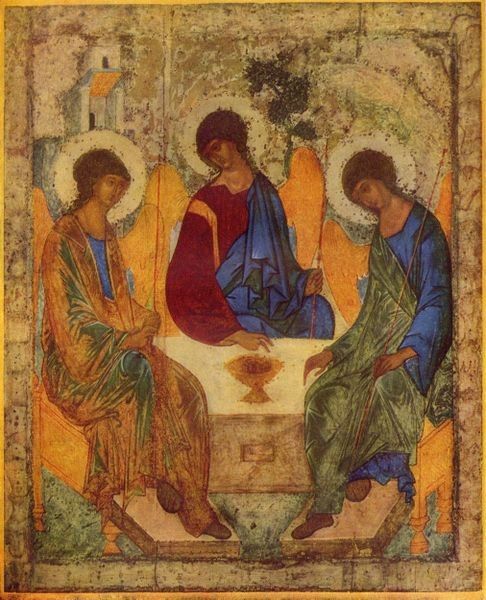
The Trinity—A Glorious Reality
“I love the Father. I love His Holy Son. I love the Spirit. I love the three in One. For He created me, redeemed and set me free. Praise Him, praise Him, praise Him."
I was unaware, while singing this catchy song in the form of a “round” growing up, that I was singing some very important words about a deep theological reality. Nor did I know that many years later this profound, but simple song would surface as an opening sentence for a blog on The Trinity.
In considering the historical development of the Trinity the word trinity is not found in the Bible, but is a theological word that expresses the clear teaching of Holy Scripture, especially in the New Testament.
There is one God who has progressively revealed himself in three co-equal and co-eternal persons—Father, Son, and Holy Spirit—each with coordinating functions.
All things are “from” and “to” the Father (sovereign authority, will), “through” the Son (mediator, inheritance), and “by” the Spirit (empowering presence, means). The Father sent the Son, the Son is begotten from the Father not made, and the Spirit proceeds from the Father (John 15:26 NASB) and glorifies the Son. God is one ousia (Greek for “substance” or “essence”) and three hypostases (Greek for “persons”). “The whole undivided essence of God belongs equally to each of the three persons” (Ryrie, Basic Theology, 61).[1]
The first theologian of the church to use the term was Theophilus who spoke of God as trias. The great Latin church father Tertullian first developed the concept of trinitas, one God in three Persons.
Though the fathers of the church in the second and third centuries spoke of the three persons of the Godhead while recognizing that there is but one God, the councils of Nicea (A.D. 325) and Constantinople (A.D. 381) gave the fullest expression to the biblical doctrine. Augustine, On the Trinity (written between 399 and 420) hoped to provide an exposition of the biblical sources and doctrinal “grammar” of orthodox Trinitarian belief and to seek some “understanding of faith” about the Trinity.[2]
These church fathers did not create the concept of the Trinity. They were merely unfolding what was already latent within the Scriptures and revealing it in a systematic way. They were connecting the dots.
In the 13th century a Russian Orthodox iconographer captured theological essence of the Trinity in his famous icon, “The Trinity”. The tradition of using icons (frescoes, mosaics and paintings on wood) in liturgical life came to Russia from Byzantium after its conversion to Christianity in the 1100–1130s. They were pictures teaching theological concepts reflecting the acceptance of the reality of mystery.
No one can perfectly explain what we as Christians stand foundationally on – One God in three persons. It is an antimony; from Latin “anti-nomos" meaning against logic. It is not logical. Accept the Trinity because it is and it is a glorious reality. Accept the reality of our One God in three persons and enjoy the blessings of the Trinitarian Presence.
Understanding the Trinity –Three in One
Understanding the Trinity and who each person of the Godhead is helps us fully appreciate the work of the Trinity.It results in humble praise before an Almighty God. We worship One God in three persons – the Alpha and Omega of all creation.
Consider this brief list as a validation of the three persons and their function:
- One God: Deuteronomy 6:4, Mark12:29, Exodus 20:2–3; 3:13-15
- Father as God: Isaiah 63:16
- Father and Son distinct: Psalm 2:7; 68:18, Isaiah 9:6; 61:1–3, Hebrews 1:1–13
- Son as God: Isaiah 9:6
- Spirit as God: Genesis 1:1–2, Exodus 31:3, Judges 14:14, Isaiah 11:2
- Spirit indwelling believers promised by Jesus: John 14:15–21; 16:7–15; 17:8–9
The concept of the Trinity is validated by Jesus the Son Matthew 28:19 “Therefore go and make disciples of all nations, baptizing them in the name of the Father and of the Son and of the Holy Spirit.”
Living the Trinity and participating in the life of the Trinity consider these things:
Abide in Christ within His Body, the church Jesus prayed for this in John 17:23–25.
Respond to Jesus’ Invitation to COME – Matthew 11:28–30.
Pray – the act of praying is entering the conversation always going on within the Trinity, immersing oneself in the Trinitarian Presence (Exodus 33:14, Hebrews 13:5).
Meditate on the Word of God that is spiritually discernable by the indwelling Holy Spirit.
Sing and worship and praise this reality by singing or saying “The Gloria” upon waking and often, “Glory be to the Father, God the Son and God the Holy Spirit. As it was in the beginning, so it is now, and so it shall ever be world without end. Alleluia. Amen.”
Gather – We are created in the image of God (Genesis 1:26–27). God is a relational God as modeled by the Trinity. We were created with a relentless longing to participate in the lives of others. Fundamentally we are relational beings.(Richard Plass, The Relational Soul”).(Hebrews 10:23–25) gather with others in the Body of Christ and participate in all the New Testament "one anothers".
This unity and diversity within the triune God is a model for the unity and diversity we experience in everyday life, especially in the Church and in marriage (Grudem, Christian Beliefs, 41).
Consider: What would your life be like without the Trinity? What will you miss if you don’t embrace the full-orbed beauty of the Godhead?
“I love the Father. I love His Holy Son. I love the Spirit. I love the three in One. For He created me, redeemed and set me free. Praise Him, praise Him, praise Him.”
1 Ryrie, Charles C. Basic Theology .Chicago,Il. Moody Publishers. 1986,1999. p. 61
2 Historical Development of the Trinity, Nelson Study Bible p, 1027-1028.
Picture Credit:Andrey Rublyov (c. 1360/1370-1430s) The Trinity, 1410 tempera on Panel 142×114 cm
The Tretyakov Gallery,Moscow, Russia: source C The State Tretyakov Gallery, Moscow, 2003,2004
Suggested reading –#30 How to Explain the Trinity to a Child @ jonathanmorrow.org
Boa, Kenneth. The Trinity, A Journal,Spiritual Formation Through Personal Encounters with Scripture.Colorado Springs, CO: NavPress,2001.
Grudem, Wayne.Bible Doctrine, Essential Taching of the Faith. Grand Rapids,MI.Zondervan.1999.


